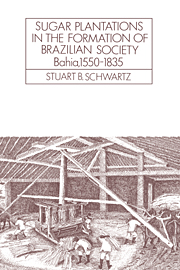Book contents
- Frontmatter
- Contents
- List of figures, maps, and tables
- Preface
- Abbreviations and special terms
- Weights and measures
- Dedication
- Part I Formations, 1500–1600
- 1 The sugar plantation: from the Old World to the New
- 2 A wasted generation: commercial agriculture and Indian laborers
- 3 First slavery: from Indian to African
- Part II The Bahian engenhos and their world
- Part III Sugar society
- Part IV Reorientation and persistence, 1750–1835
- Appendixes
- Notes
- Glossary
- Sources and selected bibliography
- Sources of figures
- Index
- CAMBRIDGE LATIN AMERICAN STUDIES IN PRINT
3 - First slavery: from Indian to African
Published online by Cambridge University Press: 05 May 2010
- Frontmatter
- Contents
- List of figures, maps, and tables
- Preface
- Abbreviations and special terms
- Weights and measures
- Dedication
- Part I Formations, 1500–1600
- 1 The sugar plantation: from the Old World to the New
- 2 A wasted generation: commercial agriculture and Indian laborers
- 3 First slavery: from Indian to African
- Part II The Bahian engenhos and their world
- Part III Sugar society
- Part IV Reorientation and persistence, 1750–1835
- Appendixes
- Notes
- Glossary
- Sources and selected bibliography
- Sources of figures
- Index
- CAMBRIDGE LATIN AMERICAN STUDIES IN PRINT
Summary
Since the gentiles of Brazil unlike those of the African coast do not have the custom of daily labor and farm only when in need, relaxing when they have enough to eat; they thus greatly suffer the new life, working by obligation rather than out of desire, as they had in the state of freedom; and in its loss and in their repugnance to, and thought of, captivity so many die that even at the lowest price they are expensive.
Sebastiāo da Rocha Pitta (1720)The Brazilian sugar-plantation colony began with the extensive use of Indian labor. From the vantage point of the present, Indian slavery appears to have been a passing moment in this history of colonial export agriculture in Northeast Brazil–and so it was. But to leave this formative stage with only a systemic account of its position within the process of European expansion, or to see it as simply a preview of what was to follow, is to tell only a part of the story. To the people who lived in these times, the inevitability of the transition was far less apparent. The Indians who underwent this experience inhabited a world whose perimeters were often defined by others, and the Indians were forced to accommodate themselves to new modes of behavior. From the viewpoint of the Portuguese, the period of Indian slavery was one in which the system of labor relations was worked out in detail.
- Type
- Chapter
- Information
- Sugar Plantations in the Formation of Brazilian SocietyBahia, 1550–1835, pp. 51 - 72Publisher: Cambridge University PressPrint publication year: 1986



